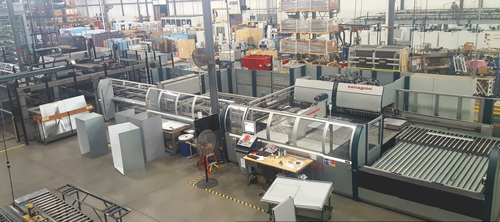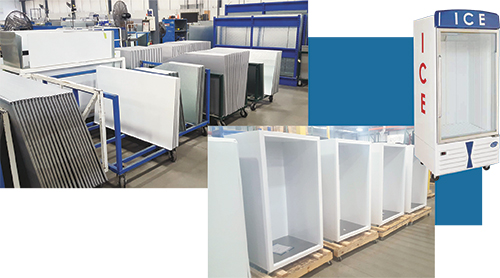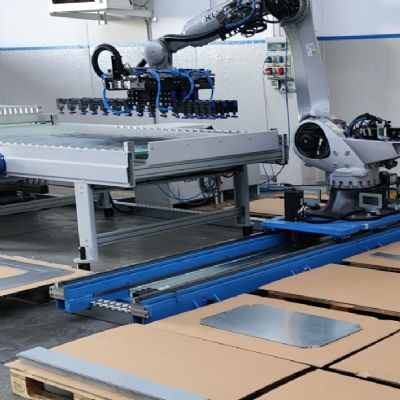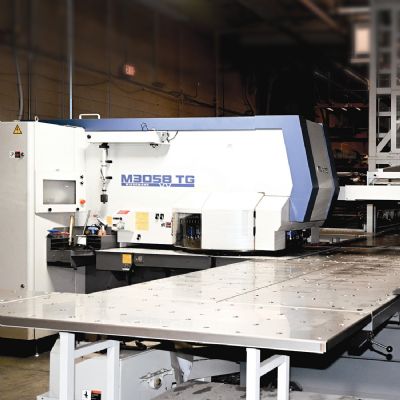Unique Punch and Bending Setups
The punch on the S4 works differently than on a conventional turret, explains Muth. All of the punch tools are live, and the machine can fire any tool at any time, even firing more than one punch at a time.
“Also, we can tool-up the punch head with redundant punches but with different die clearances, one for heavy-gauge sheet and one for lighter-gauge work (0.008-in. clearance, for example, for thin sheet and 0.014-in. clearance for thicker work). We have enough capacity in that machine to run material 12- to 26-gauge thick without tool changes. Before, we were constantly changing turret-press tools as die clearance changed.”
Likewise, the P4 panel bender works completely differently than does a conventional press brake. It uses lateral bending force to form sheetmetal, generated by a pair of oscillating blades. The machine’s manipulator quickly and accurately moves the sheet, in order to position the side to be bent in front of the blades. A blankholder grips the material as the blades work their magic, making any number of bends up or down in rapid succession. Processing time is minimized since the blank only needs to be centered once, at the beginning of the process. This, according to Salvagnini, keeps cycle time, and more importantly, dimensional errors, to a minimum.
“We obtain tighter seams between panels with the P4,” Muth says, “which in assembly are hinged, snapped and locked together—no welding or fasteners needed. And, the operators no longer need to use a hammer to close the seams, as before. While the new design was challenging to engineer and could not be repeatably manufactured before, it now saves a lot of time in assembly. Assembly time has been reduced significantly, primarily due to the capabilities of the panel bender. It definitely gives us a competitive advantage.”
Finally, Muth notes that the single-sheet delivery system employed by the storage tower adds further to the flexibility provided to the FMS operators. “Most towers,” he says, “require the machine to feed off of one pallet of material at time. The tower that Salvagnini has designed and its single-sheet delivery systems give us instant access to run 12 different pallets of material, one sheet right after the next. Also, if there’s an emergency of a nonscheduled production run and the pallet of material is not in the tower, the operator can just slide a pallet of material underneath the tower and the manipulator will pick up one sheet at a time—there’s no need to shut the line down in order to load raw material. The tower is never a bottleneck.”
Empowered Workers
Leer has enjoyed multiple days with more than 22 hr. of green-light time on the panel bender during a 24-hr. shift schedule, and an even higher run-time percentage on the shear/punch.
“We typically see well over 1000 panels produced per day off of the panel bender,” Muth says. That productivity, he notes, largely is due to empowered operators who schedule the line to level-load the panel bander and shear/punch as best they can. To help, the FMS includes three buffer stations.
“Our operators have done a great job managing the work flow through the FMS,” says Muth. “They can, for example, look at which jobs have longer bend-cycle times and which will stay in the S4 longer, and juggle the schedule to better help balance the line so that one machine isn’t waiting for the other.” MF
View Glossary of Metalforming Terms
See also: Salvagnini America, Inc.
Technologies: CNC Punching, Fabrication, Materials
Comments
Must be logged in to post a comment. Sign in or Create an Account
There are no comments posted.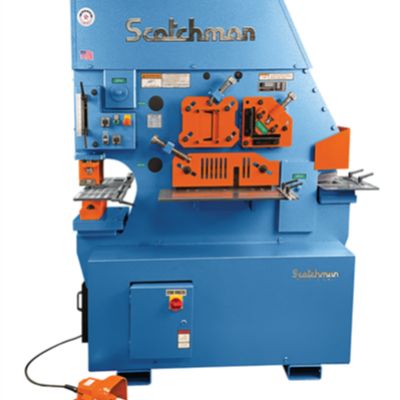 CNC Punching
CNC PunchingScotchman Introduces FI 125-Ton Integrated Ironworker
Monday, May 12, 2025







